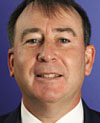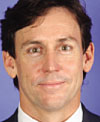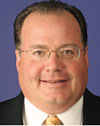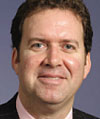Jefferies has managed to grow and maintain an entrepreneurial partnership culture. It now needs to seriously beef up its brand. Will it be able to get to the next level without sacrificing its character, asks Geraldine Lambe .
The marbled foyer of its high-rise headquarters on the corner of Madison Avenue and 53rd Street in New York looks like that of any bulge bracket investment bank. It has the art collection – including an impressive chunk of the Berlin Wall – that now seems to be an obligatory part of a bulge bracket’s corporate personae. But within the offices of Jefferies Investment Bank beats the heart of a different beast.
With its focus on mid-market companies, it does not take a $20bn deal to quicken a Jefferies banker’s pulse; they are just as excited by a $50m initial public offering (IPO) or a $150m high yield offering. The bank eschews bureaucracy and lionises the entrepreneurial.
|
|
Its most senior people still pitch on deals and take pride in being ‘producers’ – chairman Brian Friedman and CEO and president Rich Handler both manage investment funds, for example. Staff own 53% of the firm’s stock. |
Because it deals with smaller firms, relationships are more personal and with the CEO; and being client focused is more than a goal, it is a necessity. “It is not our focus on mid-market and growth companies that makes us different; it is the character of the relationships that we have with our clients,” says Mr Handler. “By the nature of our clients’ businesses and ours, executing their deals means more to our business, and we have more of an impact on theirs.” That view is embedded throughout the firm. Without exception, every interviewee defined the difference between working for a bulge bracket and working for Jefferies as primarily one the influence their efforts can have on a client’s business, and the satisfaction of knowing they were part of that.
|
|
“More of the deals are CEO-led from start to finish, and that gives you a completely different relationship with the firm; you can add real value,” says Chris Kanoff, co-head of investment banking. “Because bulge brackets are set up to be volume shops, most deals are not the most important deal that they are working on. With us, it is always the most important deal we are working on.” |
Character retention Jefferies has retained the sort of character that many other firms sacrificed in the race for size. In the wave of consolidation that swept through the industry at the end of the 1990s and early 2000s, many of its competitors were swallowed by commercial or investment banks hoping to annexe their mid-market business. As the likes of Alex. Brown went to Bankers Trust, Hambrecht & Quist to Chase Manhattan, and Donaldson Lufkin & Jenrette went to Credit Suisse First Boston, the mid-market sector was transformed. The result, says Mr Friedman, was that “behemoth banks and corporate types overran Wall Street and the City, and they lost something along the way. We are in many ways still the old-fashioned type of firm; we have retained a partnership culture and a belief that human capital and the drive to succeed are more important than the size of the balance sheet.” In truth, some of Jefferies’ strengths are a feature of its size and client base: it is easier for a smaller firm to be more client focused; and it is easier for managers to be more entrepreneurial if they are not tied up in the red tape that comes with 25,000 employees. It may prove difficult for Jefferies to keep its entrepreneurial culture as it grows and not fall prey to the service constraints that accompany larger-scale operations.
Another major challenge is to build its brand. It lacks the name recognition that beefier competitors such as Morgan Stanley, Goldman Sachs and JPMorgan command and yet it increasingly has to pitch against such giants.
In this respect, size is also an issue. Although it has a slightly different business model than some of its closest mid-market competitors, it is still smaller in terms of market capitalisation, revenues and earnings than Raymond James and AG Edwards, for example. So when Wachovia announced that it would buy 120-year old mid-market broker AG Edwards earlier this year, with the broker citing the need for scale and a broader range of products, it sparked talk that there may be a new round of consolidation. Some pundits have suggested that it may be difficult for Jefferies to stay independent as its need for capital grows.
That said, Jefferies has already grown rapidly, boosting its market capitalisation from $0.5bn in 1999 to about $4.5bn today, and increasing headcount from 800 to more than 2300 in offices around the world. Its share price has rocketed by 401% (from $5.22 in April 1999 to $27.56 in June this year), outstripping the performance of fellow mid-market firms such as Raymond James Financial and successful bulge-bracket firms like Lehman Brothers (see table).
The architect
Mr Handler prefers to stay in the background. He only agreed to be interviewed for this article if all of the senior management were involved (and declined to give us a photo). Reticence notwithstanding, he is largely the architect of the modern Jefferies.
Since becoming CEO after a bloodless coup in 1999/2000, he has orchestrated its metamorphosis from a mid-market sales and trading firm into a full service investment bank. Mr Handler’s putsch (with then head of equity sales, John Shaw, who became co-president and chief operating officer and has since retired) was prompted by the spin-off of Jefferies’ technology-based equity trading business, Investment Technology Group (ITG), in 1999; while Jefferies’ market cap had stalled at $0.5bn, ITG IPO-ed at $2.5bn.
“We had arrived at a point where the child was a lot more efficient and well run than the parent. Our various divisions worked very well in and of themselves, but there was a lack of integration,” says Mr Handler. “I wasn’t totally happy with the way things were going – there were so many things that we could have done better – so we approached senior management with an idea for the future. They embraced it and gave us the opportunity to go forward.”
Over the next three or four years, Mr Handler laid foundations for better performance. He redistributed share ownership so that partners “shared in success and felt the failure”, and used that as a chisel to chip away fiefdoms and turn the firm into an integrated offering.
Facing up to the fact that ITG’s success had helped to mask the company’s weaker performance, he cut out a layer of costly managerial fat that he believed was preventing the producers from playing a full role in decision-making. “And stripping $30m of cost out of a $0.5bn company didn’t hurt,” says Mr Handler.
More fundamentally, he repositioned the firm. As the bulk of mid-market firms disappeared into the clutches of larger institutions, Mr Handler reasoned that Jefferies had to find a niche where it could add value and make money. More importantly, it had to be defendable. The obvious gap was that left between the bulge bracket offerings, which targeted the big money accounts, and the remaining mid-market firms, which lacked Jefferies’ sales and trading platform.
“The middle market is under-covered, under-banked and under-researched on Wall Street, so our thought was to build a full service bank by aligning our banking capabilities with the trading platform and trying to bank the clients where we trade their stock; we added research so that we have an opinion on the stocks that we trade,” he says.
Facing a burst bubble
It was a challenging environment. No sooner was the new management in place than the tech bubble burst and Nasdaq fell apart, losing 25% by June 2000. In hindsight, it was advantageous. From 1990 to 1999, Mr Handler admits it had been difficult to attract the right people; suddenly, with the rest of Wall Street bloated and making brutal staff cuts, Jefferies had the opportunity to make significant hires.
Between 1999 and 2003, Jefferies delivered record results, analysts began to take notice and the share price perked up. But Mr Handler realised that the firm still lacked depth in key industry verticals and that organic growth was not getting the firm where he wanted it to go fast enough: achieving critical mass in those key verticals quickly meant buying it.
Through a series of advisory boutique acquisitions, Jefferies began seriously bulking up its investment banking department, aiming to weld the mergers and acquisitions (M&A) relationship to its existing sales and trading expertise, and to broaden the firm’s platform. Thus it added verticals in aerospace and defence with its acquisition of Quarterdeck in December 2002, technology (Broadview, December 2003), oil and gas (Randall & Dewey, February 2005), and private equity fund placement (Helix, May 2005). The acquisition trail continues: in June, European online and media, and financial institutions expertise were added to the stable with Jefferies’ acquisition of Longacre and Putnam Lovell (from Canada’s National Bank Financial Group), respectively.
This was not the first overhaul that Mr Handler had done at Jefferies. His very arrival at the firm heralded significant change. Mr Handler went to Jefferies directly from the wreckage of Drexel Burnham Lambert, where he had been a senior bond trader, with a team of 18 former Drexel people, of whom three are still there: Andrew Whittaker, now vice-chairman and co-head of investment banking; Chris Kanoff, now executive vice-president and co-head of investment banking; and Brent Stevens, now executive vice-president and head of leveraged finance.
It does not at first seem an obvious move for a bond trader from a high profile, high yield shop to move to a low profile, equity trading firm, but in a scene that would be replayed nine years later, Mr Handler saw scope for improvement and approached Jefferies with a plan to reshape and reinvigorate its business. Aside from the fact that he “needed the job”, Mr Handler says the platform offered a unique opportunity. “There was no bond trading, no investment banking, no research, just a wonderful equity trading platform. It gave me the chance to see if we could build something as opposed to just being part of something.”
The board, too, saw the potential, and gave Mr Handler and his band of men $30m of capital with which to found a high yield trading business and the beginnings of an investment banking platform. The deal was that, after expenses, the firm and the group from Drexel split the profits 50:50.
Just as it would be difficult in 1999-2000, it was not an easy time to start something new. There was a recession; Drexel had gone bust and the high yield market was in complete disarray; the US savings and loans sector was in big trouble and a huge amount of liquidity had simply vanished out of the market.
Beginning by trading bonds out of the distressed market and into value investors, junk bonds became Jefferies’ second most profitable sector within only two years. As the firm began to secure a few restructuring and small investment banking mandates, the trading firm began to morph into an investment banking operation.
|
|
“There wasn’t a lot of financing going on in 1990. It was a tough time,” says Brent Stevens, co-founder of the investment banking department at the time. “Having come from an organisation where size was not an issue and the phone rang off the hook non-stop, we were painfully aware of how small we were. We made a hell of a lot of outgoing phone calls. We knew that with just 15 bankers, the only way we could compete was by over-serving the customers.” |
Since then, Mr Handler and the rest of the management team have focused on rounding out the firm’s offering and diversifying its revenue streams. Sales and trading now accounts for 47% of revenues versus 78% in 2000 and, while larger investment banks have seen the proportion of revenue from investment banking shrink (to 14.9% at Goldman), Jefferies has grown it from just 15% in 2000 to 48% in Q2 2007. Asset management, though, is still weak – accounting for only 8% of revenues in full year 2006.
Mid-market Goldman?
For all that a full service offering is seen as critical to drive growth and serve clients, sales and trading are still the guts of the firm. Historically, it has dominated this business in the mid-market sector and it is still the leading player in block trading in the $25m-$50m sector. Last year, data from Thomson Financial’s AutEx system showed the firm to be a top five trader in more than 2500 stocks.
|
|
Cliff Siegel, head of Jefferies International, based in London, says this expertise is what gives Jefferies an edge over mid-market competitors. “Our trading and distribution backbone has been in place for more than 30 years; it’s what makes us different and it’s extremely difficult to replicate. You’ve got to have a lot of experience and long-term relationships. You can’t easily build that from scratch.” |
It also makes it extremely difficult for new competitors to enter the market, says Mr Friedman. “A lot of M&A and investment banking boutiques have been started over the past few years, but there hasn’t been one successful sales and trading boutique started because you need scale and critical mass.”
Jefferies’ culture is still dominated by a sales and trading mentality. One analyst says the firm bears more than a passing resemblance to Goldman Sachs. “It has a strong proprietary trading ethic – its two top people run private equity and high yield funds – and the firm defines itself by its strong partnership culture. There are many similarities,” he says. Even Goldman analyst, William Tanona, while not going that far, has described Jefferies as “the bulge bracket of the middle market”.
Mr Handler is amused by such a comparison. “If I had to pick one firm to own, it would be Goldman Sachs – they mint money in 27 different ways.” But he says Jefferies is not aiming to be a mid-market Goldman. “We’re Jefferies and that stands for something by itself. I don’t think there is any deal that Morgan Stanley or Goldman or Lehman can do for any of our clients that we can’t do,” he says.
This needs to be more than bold rhetoric. The league tables show that, even in its mid-market niche, Jefferies has to pitch against the deeper resources and larger balance sheets of the bulge bracket firms on a daily basis.
Mr Kanoff says that Jefferies’ organisational set-up and culture make it the best partner in the growth sector. “We are not doing, per banker, as many transactions as a banker at a bigger firm, so we can spend longer working on the distribution side. That is crucial for our clients who are by definition smaller, leveraged or growing very fast. Bulge brackets do a great job selling deals that the market knows about and wants to do. We do a great job of getting the market to understand and buy deals that they do not know about and may not be interested in, but which they should be interested in.”
A brand to brandish
The challenge is making potential clients believe that. Just as the head of information technology would never be fired for buying IBM, so a chief finance officer will never be fired for hiring Morgan Stanley.
|
|
Paul Deninger, CEO of Jefferies Broadview, says that clients must not be hung up on image though. “A Gucci bag is just a bag,” he quips. But he admits that Jefferies’ weakness is that its brand has not yet caught up with its capabilities. |
He argues that analysis of data from Bloomberg shows Jefferies is the natural home for such companies; all Jefferies can do is keep plugging this message to potential clients. “We looked at all the IPOs done in the past two years for firms with less than $1bn market cap [Jefferies’ target market] to find out which of those firms are still being covered by the investment bank that took them public. Of the firms in the top six of the league table [all bulge brackets aside from Jefferies], we are the only one still covering 100% of their clients. Two firms cover 90% or less; three firms cover 80% or less.” The reason is clear, he says. “Doing an IPO of that size is an unnatural act for bulge bracket firms.”
Size is clearly an issue and, while stressing that Jefferies wins more mandates than it loses, Brent Stevens highlights the firm’s dilemma. “We recently lost out on a mandate to provide staple financing. We should have won it – the company was firmly in our space – but, although the terms were the same and the outs were the same, the client ended up using a bigger firm.”
Jefferies has taken steps to combat this disadvantage. In addition to its six acquisitions in the past five years, it has formed strategic alliances to boost capacity. In October 2004, it created Jefferies Finance in partnership with Massachusetts Mutual Life Insurance Company (MassMutual), in a bid to match the larger cheque books of rival firms. In Q2 this year, it originated $2.2bn in loans.
“We had problems competing in terms of senior lending capacity,” says Mr Handler. “We wanted to enter that business, but in an intelligent way; we didn’t want to wind up doing a bunch of dumb loans to get the [investment] banking business, so we looked for a partner who had a great track record in structuring and pricing these loans.”
In January last year, that relationship was extended when MassMutual invested $125m in convertible preferred stock of Jefferies.
However, Mr Handler denies that size prevents the firm from doing the business it targets and argues that size pressure never stops. “If we were two, three or even four times as big, we would still be asking if we should be bigger. We are big enough to pretty much do whatever business we want to do.”
In the flurry of rumours following Wachovia’s plan to acquire AG Edwards and the rise in shares of other brokerages and mid-market investment banks, Raymond James Financial, Edwards Jones and Jefferies were all posited as likely candidates. One rumour suggested that MassMutual was in the running to acquire Jefferies. “Such a deal would make pretty good sense,” says an analyst. “Jefferies is growing fast and could probably benefit from more capital, while MassMutual clearly believes Jefferies’ is an attractive proposition.”
Mr Handler brushes off any takeover rumours and denies that Jefferies will need to partner to compete. “We now have $3.5bn of long-term capital and strategic relationships that allow us to compete against our larger competitors on a global basis… and will continue to seek similar partnership opportunities as we further extend our platform.”
Despite the firm’s continued growth, and seven successive years of record earnings, the market seems to be less enamoured with Jefferies’ stock. After years of sparkling growth, Jefferies’ share price stalled at the beginning of last year: barring a few spikes, on July 9 this year it was pretty much the same price as it was at the end of January 2006.
Mr Handler is pragmatic. “I think that perhaps our share price got a little bit ahead of us, but other financials are experiencing the same phenomenon,” he says. “Ultimately, the price will reflect performance.”
And there are plenty of plans on the table to fuel further growth: aside from continuing to build its investment banking and asset management business, increasing revenues from its international business is a key target. It has operations in London, Dubai, Tokyo, China, India and Singapore, and last month announced plans for a Frankfurt office.
Plans for growth
International efforts are already gaining some traction. Jefferies has carved out a profitable niche in foreign currency convertible bonds for Indian companies and has raised more than $1bn in financing for India-based companies in the past 18 months. In March, it was exclusive financial adviser for the £479m acquisition of Aston Martin from Ford Motor Company by a consortium of investors, and in April it was bookrunner (alongside Lehman Brothers) on its first equity offering in China ($110.6m) for electronics supplier Comtech Group.
|
|
“International business accounts for about 12% of revenues but it should be 30%-50% so there is inherent growth there,” says David Weaver, appointed head of international investment banking in June (from Deutsche Bank Alex. Brown). “There are growth opportunities everywhere, it’s more about making sure we pick the right ones, focusing on those, and not spreading ourselves too thin.” |
Applying Jefferies’ niche philosophy across other areas is generating growth potential.
|
|
For example, Ross Stevens, co-head of equities, says that there is a ripe opportunity created by bulge bracket firms’ lack of interest in smaller hedge funds. “The big firms have powerful platforms, but they are entirely focused on big hedge funds. Our eureka moment came when we realised that they wouldn’t return the call of the $400m hedge fund manager, yet 90% of hedge funds manage below $1bn and they are crying out for technology, research, back-office services and trading. It leaves a gap for us to fill,” |
he says. Since launching its prime brokerage in November 2006, Jefferies has signed up 60 clients. Finding potential areas to develop and maintain revenue momentum is clearly not a problem. Managing growth without losing the culture will be more difficult. For one thing, what Jefferies calls the “player-coach” style – in which the CEO pitches on deals and manages a $2bn proprietary high yield and special opportunities fund – may not be the best use of senior management’s time as the firm continues to grow. But pulling producers away from deals to focus on management and paperwork will not be easy in such an entrepreneurial firm. Bureaucracy is a dirty word at Jefferies.
|
|
“The day the firm has a layer of bankers that just do admin is the day that Jefferies dies,” says Adam Sokoloff, group head, private equity coverage at Jefferies. |
Waging war against autocracy
Mr Handler maintains that the management team is able to balance time between different roles and that “autocracy” would not work at Jefferies. And, as clients get bigger, sticking with them without changing the firm’s unique selling proposition will be tricky. First is the issue of whether Jefferies will be able to grow with its clients and continue to serve them as their demands get bigger: mid-sized firms may not stay that way.
Mr Sokoloff cites recent work with an existing client, Oak Hill Capital Partners. “We made a $900m commitment that would have enabled them to acquire a business that would have been transformational to their platform. Sadly, in the end they didn’t win the bid, but the point is that we were able to write that size commitment; and it was because we wanted to stay committed to them. And that envelope [the possible size of transactions] keeps being pushed as Jefferies grows.”
There is an almost evangelical zeal in the way that Jefferies talks about its business. The firm is infused with the notion of serving those firms that are underserved by Wall Street. It may be no coincidence that Mr Handler and several of Jefferies’ managing directors cut their teeth at Drexel Burnham Lambert – a firm which created the junk bond market and gave non-investment grade companies access to the corporate bond market on reasonable terms for the first time. There is more than a hint of a ‘Drexel inheritance’ at this firm. Mr Handler is proud of his time at Drexel and what the firm achieved for its clients. “I would never be as presumptuous as to say that we hold that mantel, but I will be very proud if our clients think of us in the same way that Drexel’s clients thought of that firm.”
If it grows with clients, a natural progression would be for Jefferies to target other larger clients, leading it further away from its core mid-market focus. This trajectory is suggested by the bigger deals it is bagging, such as adviser to Kronos in its $1.8bn acquisition by Hellman Friedman in June.
Moreover, its continued diversification into prime brokerage, asset management and proprietary trading will drag it closer to the business model of the bulge brackets. Mr Deninger highlighted the fact that 48% of revenues comes from investment banking but, as at larger investment banks, that percentage will shrink as it diversifies its platform. Will Jefferies become the very thing against which it currently defines itself?
“The definition of what is a mid-market company will continue to morph [get larger], but we will continue to focus on mid-sized and growth companies,” contends Mr Handler. “The day we start believing our clients owe us business or we start to take our 2311 employee-partners for granted is the day we become just another arrogant Wall Street firm.”










